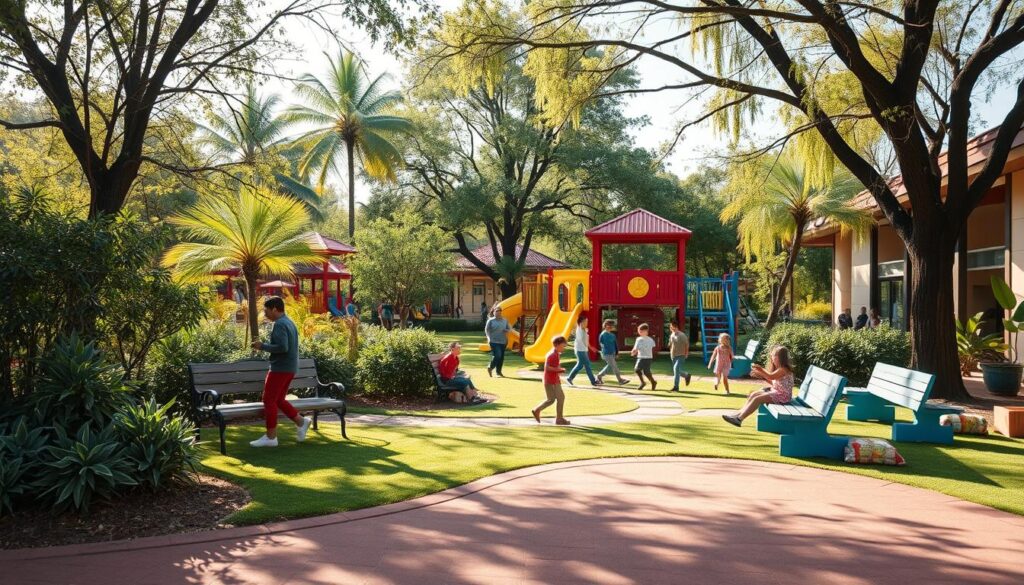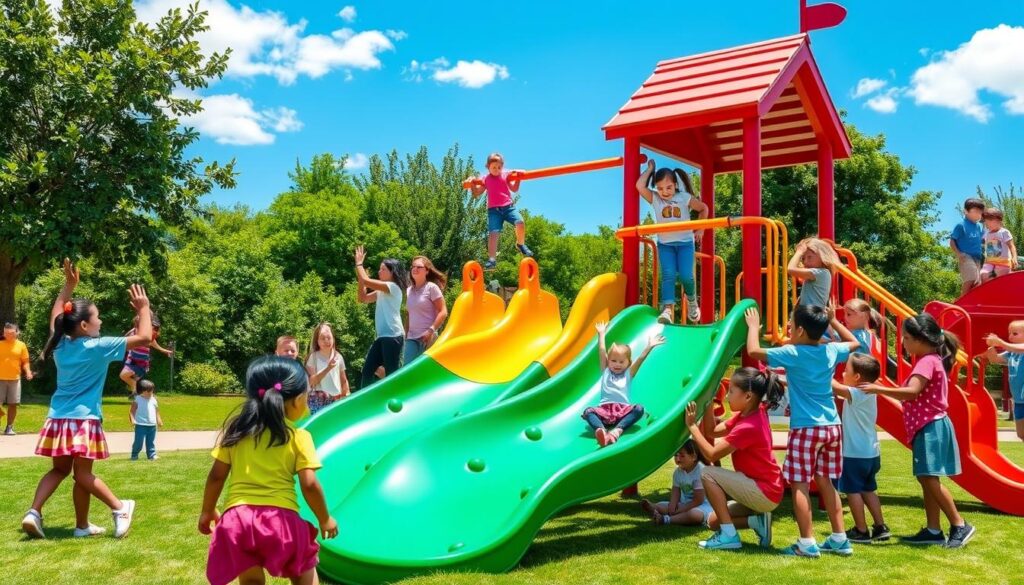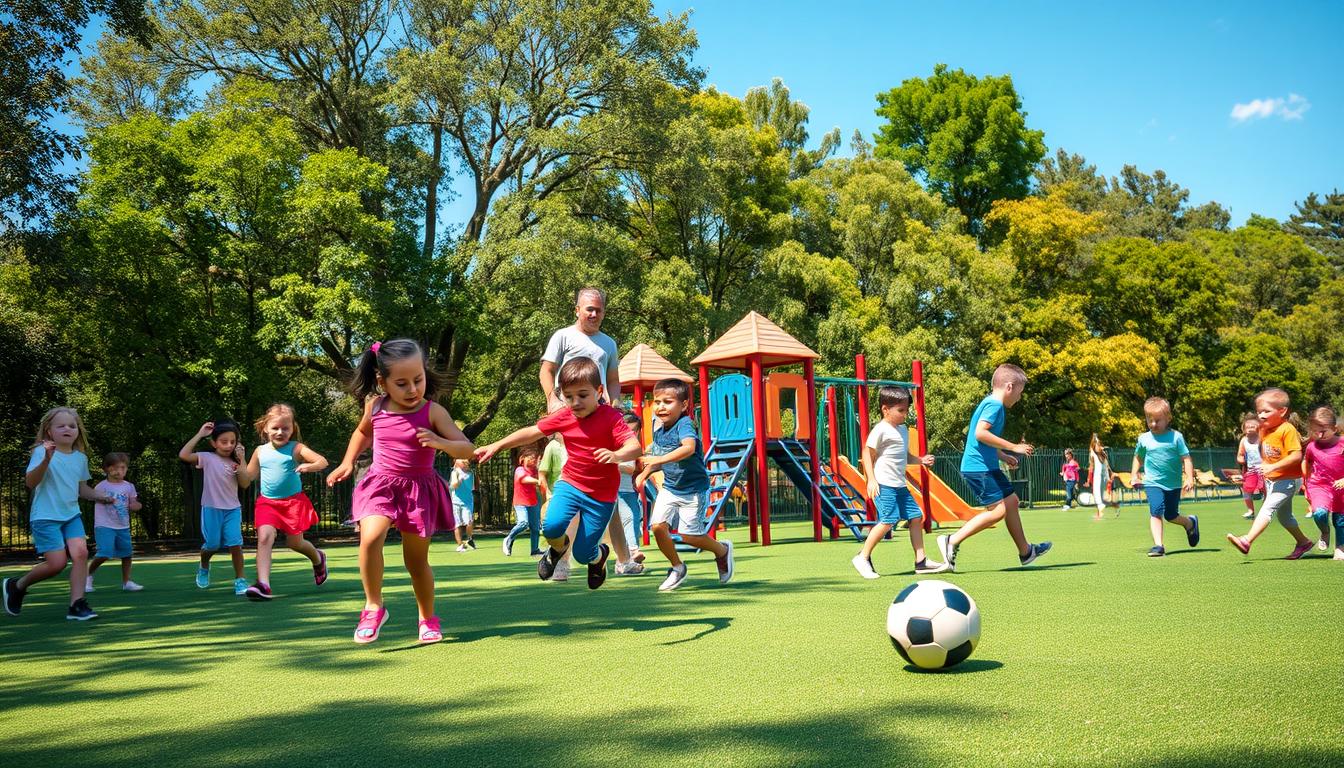As a parent or caregiver, you play a crucial role in building resilience in children. Resilience enables kids to bounce back from tough times and thrive despite challenges. It’s not an inherent trait but a skill that can be nurtured and developed over time.
By teaching your child the right skills, you can help them face life’s ups and downs with confidence. This article will show you how to help your child develop resilience. You’ll learn about emotional intelligence, a growth mindset, and more to support your child’s journey.
- Understanding Childhood Resilience: A Foundation for Growth
- Resilience in Children: Developing Tools to Cope with Difficulties
- Emotional Intelligence as a Building Block for Resilient Children
- Creating a Supportive Environment for Resilience Building
- Mindfulness and Stress Management Techniques for Kids
- The Role of Growth Mindset in Building Resilience
- Handling Adverse Childhood Experiences: A Trauma-Informed Approach
- Physical Activities and Movement for Emotional Regulation
- Building Strong Social Connections and Support Systems
- Fostering Problem-Solving Skills and Independence
- Conclusion
- FAQ
- What is resilience in children and why is it important?
- How can I help my child develop emotional intelligence?
- What role does a supportive environment play in building resilience?
- How can mindfulness and stress management techniques benefit children?
- What is the role of a growth mindset in building resilience?
- How can I support a child who has experienced adverse childhood experiences?
- How can physical activity and movement benefit a child's emotional regulation?
- Why are strong social connections and support systems important for building resilience?
- How can I foster problem-solving skills and independence in my child?
Understanding Childhood Resilience: A Foundation for Growth
Building resilience in children is key for their development and mental health. It’s important to understand how resilience forms. This knowledge helps us teach this vital skill to kids.
The Science Behind Resilience Development
Resilience starts with the brain’s ability to adapt to tough times. Studies show that both good and bad childhood experiences shape our brain’s resilience. By focusing on positive experiences and teaching coping skills, we can help kids build resilience.
Key Components of Childhood Resilience
- Emotional regulation: The ability to manage and express emotions in a healthy way.
- Problem-solving skills: The capacity to identify and address challenges effectively.
- Positive self-image: A strong sense of self-worth and confidence.
- Social support: Nurturing relationships with family, friends, and community.
Why Resilience Matters in Modern Society
In today’s world, resilience is more crucial than ever. Kids who are resilient can handle life’s ups and downs better. They bounce back from hard times and keep their mental health strong. By focusing on resilience, we prepare the next generation to face challenges head-on.
“Resilience is not something that children either have or don’t have; it involves behaviors, thoughts, and actions that can be learned and developed in anyone.”
| Key Components of Childhood Resilience | Description |
|---|---|
| Emotional Regulation | The ability to manage and express emotions in a healthy way, helping children cope with challenges and setbacks. |
| Problem-Solving Skills | The capacity to identify and address challenges effectively, fostering a sense of control and self-efficacy. |
| Positive Self-Image | A strong sense of self-worth and confidence, which can bolster a child’s resilience in the face of adversity. |
| Social Support | Nurturing relationships with family, friends, and community, providing a foundation of care and encouragement. |
Resilience in Children: Developing Tools to Cope with Difficulties
Building resilience in children is key for their mental health and happiness. By teaching them coping skills and a positive outlook, you help them face challenges with confidence. Emotional intelligence and positive psychology are powerful tools for building resilience in kids.
Emotional intelligence is crucial for resilience. When kids can manage their feelings, they deal better with stress. Encourage them to express feelings through journaling, art, or talking. This helps them understand and connect with others.
Positive psychology focuses on building on strengths, not just solving problems. It helps kids see challenges as chances to grow. Celebrate their wins and help them see every problem as a learning opportunity.
| Coping Mechanism | Description | Benefits |
|---|---|---|
| Mindfulness Practices | Age-appropriate meditation, breathing exercises, and integration into daily routines | Improved emotional regulation, stress management, and present-moment awareness |
| Problem-Solving Strategies | Developing critical thinking skills, brainstorming solutions, and fostering independence | Enhanced decision-making abilities, adaptability, and self-confidence |
| Physical Activities | Engaging in sports, dance, or other movement-based exercises | Improved emotional regulation, stress relief, and overall physical and mental well-being |
Teaching kids various coping skills helps them face challenges with resilience. Remember, building resilience is a journey that needs patience and understanding of each child’s needs.
“Resilience is not something that you just have. It’s something that you can build, develop, and nurture.” – Dr. Ginsburg, pediatrician and resilience expert.
Use emotional intelligence, positive psychology, and many coping strategies to help kids become resilient. This way, they can face the world with confidence and adaptability.
Emotional Intelligence as a Building Block for Resilient Children
Emotional intelligence is key for kids to be resilient. It helps them understand and control their feelings. This way, they can handle tough times and bounce back.
Recognizing and Managing Emotions
Teaching kids to know their feelings is the first step. Help them name their emotions, like happiness or sadness. Encourage them to share their feelings in healthy ways, like through art or talking.
This helps them understand and control their feelings. It’s a powerful way to help them grow strong.
Building Empathy and Social Awareness
Resilient kids can understand and share others’ feelings. Role-playing and stories help them learn this. It’s also important to help them know how to get along with others.
This social skill is vital for making friends and facing challenges together.
Self-regulation Techniques for Children
- Deep breathing exercises to manage stress and anxiety
- Mindfulness practices, such as focused attention on the present moment
- Cognitive-behavioral strategies to reframe negative thoughts
- Physical activities and movement to release pent-up emotions
Teaching kids how to calm down helps them be strong. It gives them the tools to handle tough times on their own. This builds their confidence and self-control.
| Emotional Intelligence Component | Benefit for Resilient Children |
|---|---|
| Emotional Awareness | Ability to identify and understand their own feelings |
| Empathy | Capacity to relate to and support the emotions of others |
| Self-regulation | Skills to manage and express emotions in a healthy manner |
Teaching emotional intelligence is a powerful way to help kids grow strong. It helps them face challenges with awareness, kindness, and control. These skills are crucial for success in today’s world.
“Emotional intelligence is the ability to identify, understand, manage, and reason with emotions.” – Peter Salovey and John D. Mayer
Creating a Supportive Environment for Resilience Building
Building resilience in children is a big job that needs a caring and supportive place. By making a space that values emotional health, you help kids learn to handle tough times. This part will look at what makes a supportive environment for building resilience in kids.
At the heart of a supportive environment is trauma-informed care. It knows how hard tough times can be and works to make a safe, steady, and trustworthy place. By understanding each child’s needs and helping them in their own way, you can lessen the hurt of past traumas. This helps kids grow in a positive way.
Also, using positive psychology helps a lot. It focuses on growing strengths, being hopeful, and finding purpose. By doing activities that show off kids’ strengths and celebrating their wins, you help them see they can get through hard times.
- Prioritize emotional safety and trust-building
- Incorporate strengths-based approaches and positive reinforcement
- Foster a sense of belonging and community within the environment
- Provide access to mental health resources and counseling services
- Encourage the development of coping strategies and self-regulation skills
By making a supportive environment that meets kids’ full needs, you set the stage for resilience. This mix of trauma-informed care, positive psychology, and special help can really help kids deal with tough times and grow strong.

“The greatest gifts we can give our children are the roots of responsibility and the wings of independence.” – Maria Montessori
Mindfulness and Stress Management Techniques for Kids
In today’s fast world, it’s crucial to teach kids how to handle stress. Mindfulness and stress management are key tools. They help kids become aware of their feelings and stay calm.
Age-appropriate Meditation Exercises
Meditation is great for kids. It teaches them to focus and find peace. There are many meditation exercises that fit different ages.
Breathing Techniques for Emotional Control
Breathing exercises help kids manage their feelings. Simple techniques like deep breathing can be fun and empowering. They teach kids to control their body’s stress response.
Integrating Mindfulness into Daily Routines
Mindfulness should be a part of daily life. It helps kids stay present and aware. Mindful eating or walking can make everyday life calmer and more fulfilling.
Teaching kids mindfulness and stress management is vital. These skills help them grow up with confidence and emotional balance. They support well-being and foster personal growth.
The Role of Growth Mindset in Building Resilience
In the world of child development and mental health, growth mindset is key. It was coined by psychologist Carol Dweck. It’s the idea that you can grow your abilities with effort and hard work. This is different from a fixed mindset, where people think their abilities can’t change.
Teaching children to have a growth mindset helps them be resilient. Resilience means bouncing back from tough times. With a growth mindset, kids see challenges as chances to learn, not as failures.
- Growth mindset lets children believe they can get better, giving them a sense of control.
- It helps kids focus on how they solve problems, not just the results. This builds problem-solving skills and a willingness to take risks.
- Studies show kids with a growth mindset are more motivated, do better in school, and are happier.
Using growth mindset ideas in daily life can really help kids deal with life’s ups and downs. By teaching growth mindset, parents and teachers can help kids become more resilient. This helps them face challenges and grow stronger.
| Fixed Mindset | Growth Mindset |
|---|---|
| Believes abilities are set in stone | Believes abilities can be developed |
| Avoids challenges and setbacks | Embraces challenges as opportunities for growth |
| Focuses on performance and outcomes | Focuses on the process and learning |
| Gives up easily when faced with obstacles | Persists in the face of obstacles |
By teaching children to have a growth mindset, we help them become resilient. This approach is not just for school success. It also helps with emotional well-being and personal growth for life.
“Becoming is better than being.”
– Carol Dweck, Psychologist and Author
Handling Adverse Childhood Experiences: A Trauma-Informed Approach
Adverse childhood experiences (ACEs) deeply affect a child’s mental health and resilience. It’s key to spot trauma signs and use a trauma-informed method to help. This approach builds trust, ensures safety, and uses specific recovery plans. It helps kids face challenges and grow strong.
Recognizing Signs of Trauma
ACEs show in many ways, like bad behavior, mood swings, and physical issues. Some common signs in kids include:
- Difficulty sleeping or recurring nightmares
- Aggressive or withdrawn behavior
- Difficulty concentrating or learning
- Unexplained physical complaints, such as headaches or stomachaches
- Heightened anxiety or fear in certain situations
Building Trust and Safety
Creating trust and safety is vital for kids who’ve faced trauma. This means having caring, consistent relationships and clear rules. A stable environment helps kids feel safe and supported as they heal.
Recovery and Healing Strategies
Trauma-informed care helps kids find ways to cope and feel in control. Important strategies include:
- Providing access to mental health resources and therapy
- Teaching stress management and emotional regulation techniques
- Encouraging the development of positive relationships and social connections
- Fostering a growth mindset and a sense of personal agency
By using a trauma-informed approach, we help kids who’ve had ACEs to grow strong and thrive.
“Trauma-informed care is not just about what we do, but how we do it. It’s about creating a safe, supportive environment where children feel heard, validated, and empowered to heal.”
Physical Activities and Movement for Emotional Regulation
Adding physical activities to your child’s day can greatly improve their emotional health. By doing so, you help them learn to handle tough times better. This boosts their emotional regulation skills.
Exercise is key for both physical and emotional growth in kids. It helps manage stress and anxiety. Through movement, kids can release energy, feel better, and express their feelings in a healthy way.
- Engage your child in age-appropriate physical activities, such as swimming, dancing, or simply playing at the park.
- Incorporate family workout sessions to foster a sense of togetherness and model healthy coping habits.
- Encourage your child to explore different sports and outdoor adventures to discover activities they truly enjoy.
“Physical activity is not just about building strong muscles and bones – it’s also a powerful tool for nurturing emotional resilience in children.”
By focusing on physical activities, you help your child develop ways to deal with life’s ups and downs. This builds their confidence and resilience. Let movement be a powerful tool for your child’s growth.

Building Strong Social Connections and Support Systems
Resilience in children grows best when they have strong social ties and a supportive network. It’s important to help them build friendships, bond with family, and get involved in their community. These steps are key to helping them face life’s ups and downs.
Peer Relationships and Friendship Skills
Good friendships are vital for kids’ resilience. Teaching them to communicate, empathize, and solve problems helps them make lasting connections. Encourage your child to join in group activities and playdates to improve these skills.
Family Bonding Activities
The family is a strong base for resilience. Doing things together, like playing games or going on adventures, strengthens family bonds. It also gives kids a safe place to share feelings and get support.
Community Involvement Opportunities
Getting involved in the community also boosts resilience. Support your child in joining clubs, volunteering, or attending local events. These activities help them feel connected, learn empathy, and understand the world better.
By focusing on social connections, family bonds, and community involvement, you equip your child with the tools to handle life’s challenges. They’ll grow up more resilient and confident.
| Peer Relationships | Family Bonding | Community Involvement |
|---|---|---|
| Communication skills | Game nights | Extracurricular activities |
| Empathy development | Outdoor adventures | Volunteer work |
| Conflict resolution | Quality time together | Local events |
“Strong social connections and a supportive network are essential for building resilience in children. These relationships provide a sense of belonging, emotional security, and the resources to navigate life’s challenges.”
Fostering Problem-Solving Skills and Independence
Building problem-solving skills and independence is key for kids to grow strong. These skills help them face challenges with confidence and find solutions. It prepares them to succeed in a changing world.
Teach kids to think deeply and see things from different angles. Ask them questions that make them think and break down big problems into smaller ones. This boosts their thinking and shows them they can overcome obstacles with hard work and creativity.
Helping kids become independent is also vital. Give them chances to make choices and handle tasks on their own. Let them pick their clothes, pack their bags, or manage their time. This helps them develop problem-solving skills, independence, and coping mechanisms – all important for child development.
- Encourage critical thinking by posing open-ended questions that stimulate analysis and problem-solving.
- Gradually increase the level of responsibility and decision-making opportunities for children to build independence.
- Celebrate small wins and learning experiences, reinforcing the idea that mistakes are part of the growth process.
- Provide a supportive environment where children feel safe to explore, experiment, and take calculated risks.
By teaching problem-solving skills and independence, you help kids develop the strength to face challenges. This approach prepares them to overcome obstacles and become confident, self-assured individuals.
“The greatest weapon against stress is our ability to choose one thought over another.” – William James
Conclusion
In this guide, we’ve covered the basics of resilience in kids. We’ve given you tools and strategies to help them feel emotionally strong. By building your child’s resilience, you prepare them for life’s ups and downs.
To make kids resilient, focus on their emotional intelligence. Create a supportive space and encourage a growth mindset. Teach them to handle their feelings, understand others, and control their actions. This way, they’ll face challenges with confidence and strength.
Building resilience is different for every child. Use the ideas from this article to fit your child’s needs and age. Follow positive psychology to make a caring, mindful, and problem-solving place for your child to grow.




2 thoughts on “Building Resilience in Children: Tools for Coping Skills”